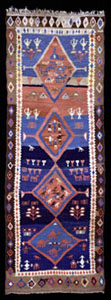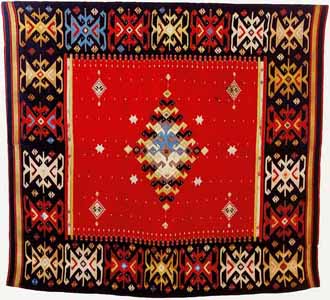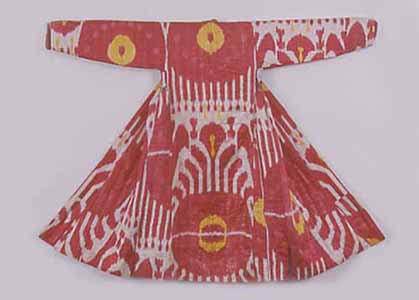
Rug. 19th century. Tapestry weave; wool. 36 x 84 in.
Collection of James D. and Stephanie Burns.
© 2002 James D. and Stephanie Burns
Along the Silk Road: Rugs and Textiles from Syria to China is an exhibition in the Henry Gallery's Short Stories series, featuring rugs, dowry textiles and silk robes from the major textile centers along the historic Silk Road of Eurasia, dating from the 13th to the 20th centuries. The exhibition includes approximately 35 objects, among them rugs from China, Uzbekistan, Afghanistan, Iran, Iraq and Syria. Rugs on loan from the prestigious collection of Seattleites James D. and Stephanie Burns have been selected to illustrate how design elements and patterns were created, abstracted and evolved as they passed along the Silk Road. Pieces from the Henry's extensive costume and textile collection are also included in the exhibition, featuring objects collected and donated by Jack Lenor Larsen, Blanche Payne and Mr. and Mrs. Burns.
The rugs in this exhibition are from major rug producing towns located along the Silk Route. They reflect distinctive regional styles, yet share common symbols. Adorning floors, walls, people and animals, rugs were both functional and decorative, serving as important commodities among upper class segments of society. Islamic cultures developed specific rugs for prayer. Silk ikat cloths, produced by wrapping and dyeing the warp and weft threads prior to weaving, were used as one type of currency. Suzani or silk embroidery held special significance as an integral part of a bride's dowry. All the objects featured in this exhibition functioned as important symbols of wealth and power.
In conjunction with the exhibition there will be two "Art Dialogues" programs, informal talks in the galleries where the textiles are on display. These talks are at 7 PM and are free with museum admission.
Thursday, February 28. Seattle rug collector James Burns, whose rugs are on loan for the exhibition, offers insights and anecdotes about the acquisition and history of these beautiful objects.
Thursday, March 7. UW history professor Daniel Waugh and Ph.D. candidate Elmira Köçümlkulkïzï explore the traditional culture of pastoral nomads, their interaction with settled regions in Eurasia and how carpet materials and motifs were the product of this interaction.

|
Urmia, Iran--Kurdish people. Rug. 19th century. Tapestry weave; wool. 36 x 84 in. Collection of James D. and Stephanie Burns. © 2002 James D. and Stephanie Burns |

|
Iran: Kermanshah Province, Songor--Kurdish people, Koliyai tribe. Rug. 19th century. Symmetrical Knot; wool. 96 x 48 in. Collection of James D. and Stephanie Burns. © 2002 James D. and Stephanie Burns |

|
Syria, probably tribal. Floor cloth. 19th century. Rib weave; tapestry weave; weft faced silk. 89 x 78 in. Henry Art Gallery, Harriet Tidball Collection, 77.7-414. © 2002 Henry Art Gallery, University of Washington, Seattle |

|
Uzbekistan, Samarkand or Ferghana region Munisak or chapan (woman's robe). Late 19th-early 20th century. Plain weave; resist dyed, warp ikat; roller printed silk warp, cotton weft and embroidery; cotton lining and batting; egg-white finish. Henry Art Gallery, Jack Lenor Larsen Collection, 96.4-2. © 2002 Henry Art Gallery, University of Washington, Seattle |